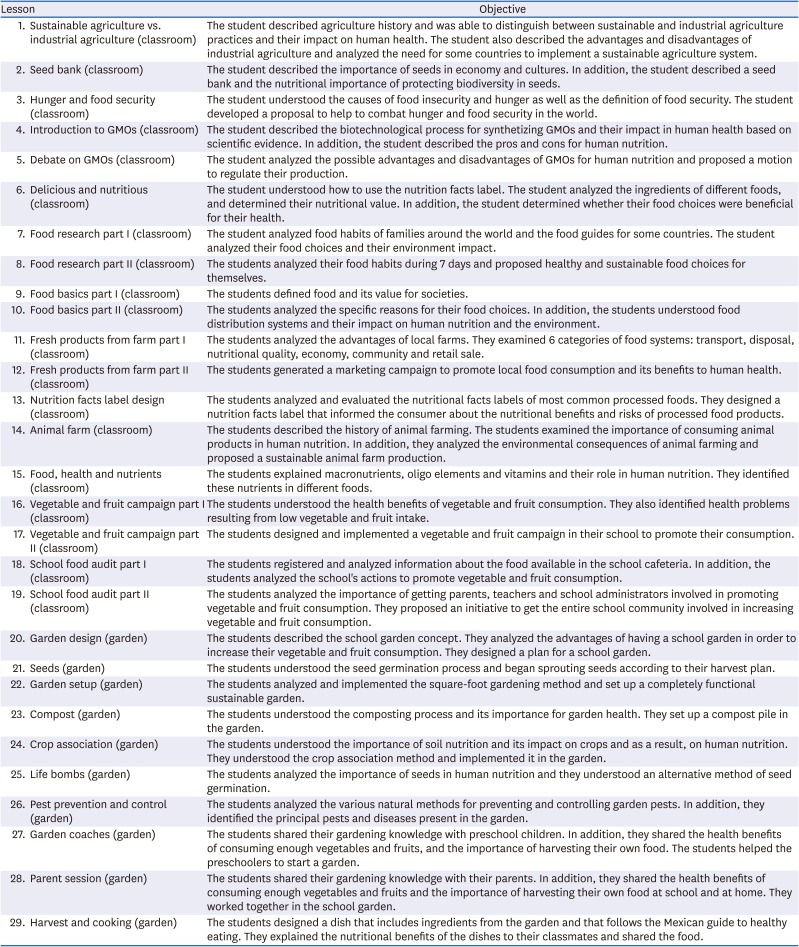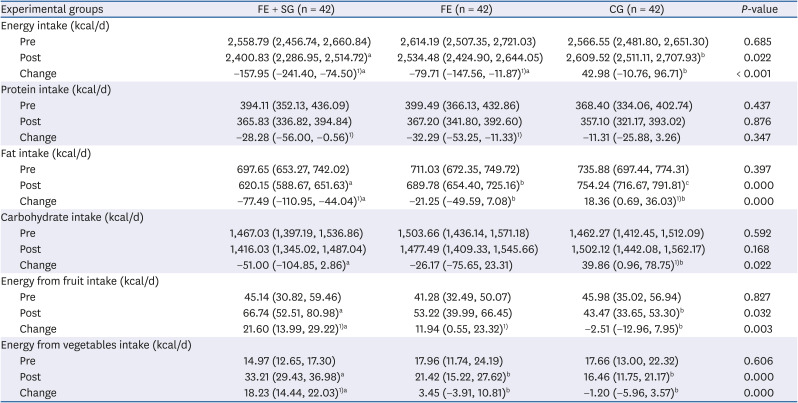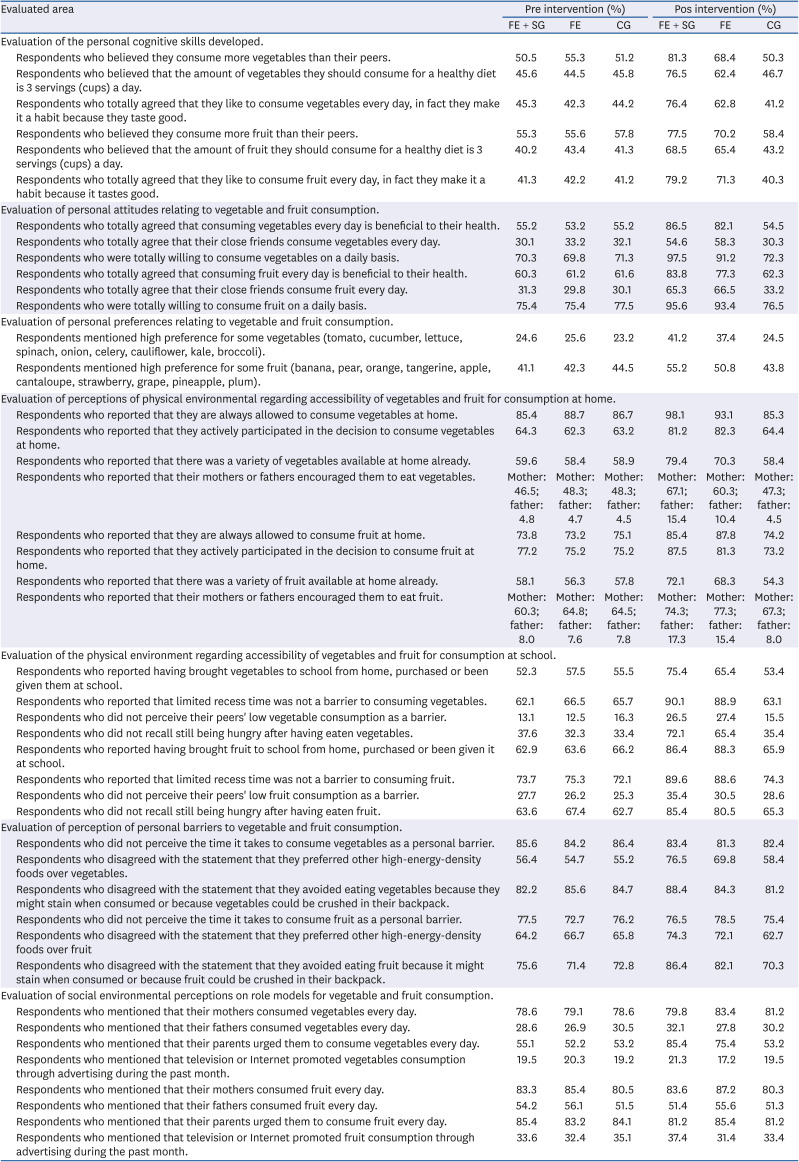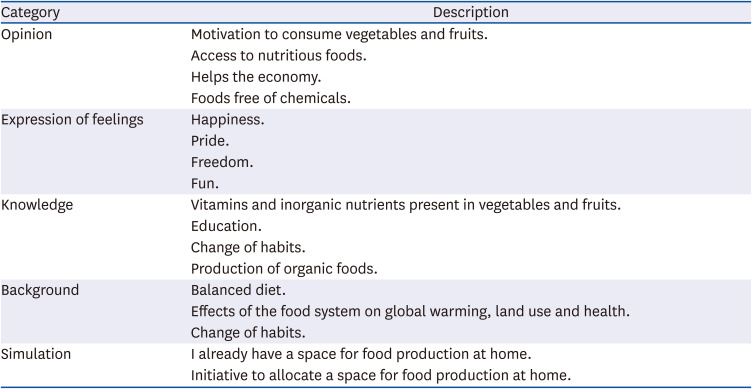1. World Health Organization. Food and Agriculture Organization of the United Nation. Diet, Nutrition and the Prevention of Chronic Diseases: Report of a Joint WHO/FAO Expert Consultation. WHO Technical Report Series: 916. Geneva: WHO;2003. p. 1–30.
2. Gao Y, Huang Y, Zhang Y, Liu F, Feng CX, Liu T, Li C, Ling DD, Mu Y, Tarver SL, Wang M, Sun W. Evaluation of fast food behavior in pre-school children and parents following a one-year intervention with nutrition education. Int J Environ Res Public Health. 2014; 11:6780–6790. PMID:
24983391.

3. Ramírez-Silva I, Rivera JA, Ponce X, Hernández-Avila M. Fruit and vegetable intake in the Mexican population: results from the Mexican National Health and Nutrition Survey 2006. Salud Publica Mex. 2009; 51(Suppl 4):S574–S585. PMID:
20464233.
4. Bai Y, Kim YH, Han YH, Hyun T. Impact of a school-based culinary nutrition education program on vegetable consumption behavior, intention, and personal factors among Korean second-graders. Nutr Res Pract. 2018; 12:527–534. PMID:
30515281.

5. Choi EB, Lee JE, Hwang JY. Fruit and vegetable intakes in relation to behavioral outcomes associated with a nutrition education intervention in preschoolers. Nutr Res Pract. 2018; 12:521–526. PMID:
30515280.

6. Gibbs L, Staiger PK, Johnson B, Block K, Macfarlane S, Gold L, Kulas J, Townsend M, Long C, Ukoumunne O. Expanding children's food experiences: the impact of a school-based kitchen garden program. J Nutr Educ Behav. 2013; 45:137–146. PMID:
23472931.

7. Morgan PJ, Warren JM, Lubans DR, Saunders KL, Quick GI, Collins CE. The impact of nutrition education with and without a school garden on knowledge, vegetable intake and preferences and quality of school life among primary-school students. Public Health Nutr. 2010; 13:1931–1940. PMID:
20441683.

8. Hazzard EL, Moreno E, Beall DL, Zidenberg-Cherr S. Factors contributing to a school's decision to apply for the California Instructional School Garden Program. J Nutr Educ Behav. 2012; 44:379–383. PMID:
22236495.

9. Graham H, Zidenberg-Cherr S. California teachers perceive school gardens as an effective nutritional tool to promote healthful eating habits. J Am Diet Assoc. 2005; 105:1797–1800. PMID:
16256767.

10. Barale K, Gaolach B, Wells NM, Myers BM, Ferenz G, Aitken M, Gao JC. Healthy Gardens, Healthy Youth. J Nutr Educ Behav. 2014; 46:S137–8.

11. García Retana JÁ. Educational model based in competenciy: importance and necessity. Actual Investig Educ. 2011; 11:1–24.
12. Rychen DS, Salganik LH. Las Competencias Clave Para el Bienestar Personal, Social y Económico. 1st ed. Granada: Enseñanza Abierta de Andalucía, Consorcio Fernando de los Ríos;2006.
13. Pimienta J. Metodología Constructivista Guía Para la Planeación Docente. 2nd ed. Naucalpan de Juárez: Pearson Education;2007.
14. Serrano JM, Parra RM. Constructivism today: constructivist approaches in education. Rev Actual Investig Educ. 2011; 13:1–27.
15. Narváez E. Una mirada a la escuela nueva. Educere. 2006; 10:629–636.
16. Jaimez CR, Miranda KS, Moranchel M, Vázquez E, Vázquez F. Innovación Educativa y Apropiación Tecnológica: Experiencias Docentes con el Uso de las TIC. 3rd ed. México: Universidad Autónoma Metropolitana;2015.
17. Sancho Gil JM. Tecnologías Para Transformar la Educación. 1st ed. Madrid: Akal Ediciones;2006.
18. Jeavons J, Cox C, Jeavons J. The Sustainable Vegetable Garden: a Backyard Guide to Healthy Soil and Higher Yields. 1st ed. Willits: Ten Speed Press;1999.
19. Denckla T, Alcorn S. The Gardener's A-Z Guide to Growing Organic Food. 2nd ed. North Adams: Storey Publishing;2003.
20. Sherman J, Muehlhoff E. Setting Up and Running a School Garden. 1st ed. Rome: Food and Agriculture Organization of the United Nations;2009.
21. Food and Agriculture Organization of the United Nations. El Huerto Escolar como Recurso de Ensenanza-Aprendizaje de las Asignaturas del curriculo de Educion Basica [Internet]. Rome: FAO;2009. cited 2018 May 3. Available from:
http://www.fao.org/docrep/013/am042s/am042s00.htm.
22. Mercon J, Escalona-Aguila MA, Noriega Armella MI, Figueroa Nuñe II, Atenco Sánchez A, González Méndez ED. Cultivando la educación agroecológica. Rev Mex Investig Educ. 2012; 17:1201–1224.
23. Díaz Barriga Á. El enfoque de competencias en la educación: ¿Una alternativa o un disfraz de cambio? Perf Educ. 2006; 28:7–36.
24. Rodríguez IT, Ballart JF, Pastor GC, Jordà EB, Val VA. Validation of a short questionnaire on frequency of dietary intake: reproducibility and validity. Nutr Hosp. 2008; 23:242–252. PMID:
18560701.
25. Palenzuela Paniagua SM, Pérez Milena A, Pérula de Torres LA, Fernández García JA, Maldonado Alconada J. Food consumption patterns among adolescents. An Sist Sanit Navar. 2014; 37:47–58. PMID:
24871110.
26. Ferrari MA. Intake estimation by means of a 24-hour reminder. Diaeta (B Aires). 2013; 31:20–25.
27. INCMNSZ. Tables of Composition of Mexican Foods and Food Products. Ciudad de México: Instituto Nacional de Ciencias Médicas y Nutrición Salvador Zubirán;2016.
28. Ochoa-Meza G, Sierra JC, Pérez-Rodrigo C, Aranceta Bartrina J, Esparza-Del Villar ÓA. Reliability and validity of a Mexican version of the Pro Children Project questionnaire. Nutr Hosp. 2014; 30:293–300. PMID:
25208782.
29. Mertens DM. Research and Evaluation in Education and Psychology: Integrating Diversity with Quantitative, Qualitative, and Mixed Methods. 3rd ed. Thousand Oaks: Sage;2010.
30. Hernández Sampieri R, Fernández Collado C, Baptista Lucio P. Metodología de la Investigación. Ciudad de México: McGraw-Hill Education;2014.
31. McAleese JD, Rankin LL. Garden-based nutrition education affects fruit and vegetable consumption in sixth-grade adolescents. J Am Diet Assoc. 2007; 107:662–665. PMID:
17383272.

32. Loso J, Staub D, Colby SE, Olfert MD, Kattelmann K, Vilaro M, Colee J, Zhou W, Franzen-Castle L, Mathews AE. Gardening experience is associated with increased fruit and vegetable intake among first-year college students: a cross-sectional examination. J Acad Nutr Diet. 2018; 118:275–283. PMID:
29198845.

33. Zacarías I, Keller I, Muzzo S. Programes 5 a day for the promotion of consumption of vegetables and fruits. Rev Chil Nutr. 2006; 33:222–223.
34. Bontrager Yoder AB, Liebhart JL, McCarty DJ, Meinen A, Schoeller D, Vargas C, LaRowe T. Farm to elementary school programming increases access to fruits and vegetables and increases their consumption among those with low intake. J Nutr Educ Behav. 2014; 46:341–349. PMID:
24953435.
35. Greer AE, Davis S, Sandolo C, Gaudet N, Castrogivanni B. Agricultural experiences are positively associated with high school students' fruit and vegetable perceptions and consumption. J Nutr Educ Behav. 2018; 50:133–140.e1. PMID:
28988655.

36. Bell S. Project-based learning for the 21st century: skills for the future. Clearing House. 2010; 83:39–43.

37. Huesca Reynoso L, López Salazar R, Palacios Esquer MR. The food support program and the comprehensive social policy in the crusade against hunger in Mexico. Rev Mex Cienc Polit Soc. 2016; 61:379–407.
38. Bucher K. Opening garden gates: teachers making meaning of school gardens in Havana and Philadelphia. Teach Teach Educ. 2017; 63:12–21.

39. Peña Fernández E, María Reidl Martínez L. Las emociones y la conducta alimentaria. Acta Investig Psicol. 2015; 5:2182–2193.

40. Institute of Medicine and National Research Council. The Science of Adolescent Risk-Taking. Washington, D.C.: National Academies Press;2011.
41. National Institute of Statistics, Geography and Informatics. National Survey of Household Income and Expenditure (ENIGH). 2018 New Series [Internet]. Aguascalientes City: INEGI;2018. cited 2020 March 22. Available from:
https://en.www.inegi.org.mx/programas/enigh/nc/2018/.











 PDF
PDF Citation
Citation Print
Print



 XML Download
XML Download